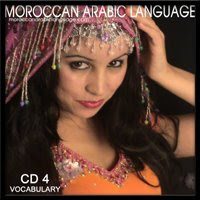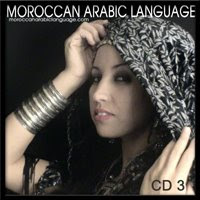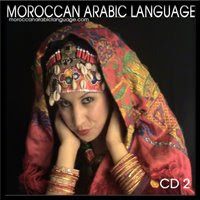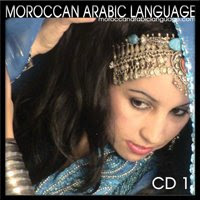
12.15.2008
9.26.2008
Learn Moroccan - Time
Learn Moroccan - Ordinal Numbers
For numbers 1 thru 12, there is a separate form for cardinal and ordinal numbers. From 13 on there is no difference between the cardinal and ordinal number.
Ordinal numbers act like adjectives, and therefore must agree in gender and number with the noun they describe. Listed are the masculine singular forms. To make the feminine form.

Ordinal numbers act like adjectives, and therefore must agree in gender and number with the noun they describe. Listed are the masculine singular forms. To make the feminine form.

Learn Moroccan - Numbers 1000, 2000, 3000 ...
The word for “thousand” has the singular form alf, the dual form alfayn, and the plural form alaf.
The plural form is used with the short form of the numbers 3 thru 10 from “3” thousand to “10” thousand. Then we return to the singular form (like we do for all Arabic nouns). Like the word for “hundred,” it is followed by “and” when the number is not an exact multiple of 1000. From 1000 onward:

The plural form is used with the short form of the numbers 3 thru 10 from “3” thousand to “10” thousand. Then we return to the singular form (like we do for all Arabic nouns). Like the word for “hundred,” it is followed by “and” when the number is not an exact multiple of 1000. From 1000 onward:

Learn Moroccan - Numbers
When we talk about numerals, we want to be able to do two things. First, we have to be able to count. That is, we have to learn our numbers. Second, we have to be able to use the numbers with objects. In other words, we have to be able to say things like “five apples” or “twenty-seven students” or “one hundred forty-three volunteers.”
In English, we never think of these two tasks separately. We simply use a number in combination with the plural form of some object. In Arabic, however, we have to learn how to combine different numbers with objects, sometimes using a plural form, sometimes a singular, sometimes with a letter in between the two, sometimes not. As in all things Arabic, what seems difficult now becomes natural with time.
Cardinal Numbers
Cardinal numbers refer to the normal numbers we use (one, two, three...). They are different than ordinal numbers (first, second, third...) and fractions (one-half, one-third, one-fourth...). For now, we start with the cardinal numbers. We will work with ordinal numbers and fractions later.
Numbers 1 thru 10
In Moroccan Arabic, there are two ways to combine the numbers 3 thru 10 with an object. We sometimes use the “full” or normal form of the number, and sometimes we use a “short” form of the number.
Here is a table listing the full form of numbers 1 thru 10 and the short form of numbers 3 thru 10.

Numbers 11 thru 19

Numbers 20, 30, 40 ... 99
For a multiple of ten (20, 30, 40 etc.) in Arabic, we simply use the name for that number, like in English. For numbers such as 21, 22, or 23, however, it is not like English. In Arabic, the “ones” digit is pronounced first, followed by the word “and,” then followed by the “tens” digit. For example, in Arabic
the number 21 is literally “one and twenty” while the number 47 is literally “seven and forty.” Also, remember that for the numbers 22, 32, 42, 52, 62, 72, 82, and 92, we do not use juj. Rather, we use tnayn. Here is a list of the multiples of ten, with examples of numbers between each multiple:

Numbers 100, 200, 300 ... 999
The Arabic word for 100 is miya. For 200, there is a dual form of miyatayn. For 300 thru 900, we use the short form of the numbers 3 thru 9 plus miya. For numbers such as 107 or 257, we will use the appropriate multiple of 100 followed by the word “and” and then the rest of the number. Some examples:

In English, we never think of these two tasks separately. We simply use a number in combination with the plural form of some object. In Arabic, however, we have to learn how to combine different numbers with objects, sometimes using a plural form, sometimes a singular, sometimes with a letter in between the two, sometimes not. As in all things Arabic, what seems difficult now becomes natural with time.
Cardinal Numbers
Cardinal numbers refer to the normal numbers we use (one, two, three...). They are different than ordinal numbers (first, second, third...) and fractions (one-half, one-third, one-fourth...). For now, we start with the cardinal numbers. We will work with ordinal numbers and fractions later.
Numbers 1 thru 10
In Moroccan Arabic, there are two ways to combine the numbers 3 thru 10 with an object. We sometimes use the “full” or normal form of the number, and sometimes we use a “short” form of the number.
Here is a table listing the full form of numbers 1 thru 10 and the short form of numbers 3 thru 10.

Numbers 11 thru 19

Numbers 20, 30, 40 ... 99
For a multiple of ten (20, 30, 40 etc.) in Arabic, we simply use the name for that number, like in English. For numbers such as 21, 22, or 23, however, it is not like English. In Arabic, the “ones” digit is pronounced first, followed by the word “and,” then followed by the “tens” digit. For example, in Arabic
the number 21 is literally “one and twenty” while the number 47 is literally “seven and forty.” Also, remember that for the numbers 22, 32, 42, 52, 62, 72, 82, and 92, we do not use juj. Rather, we use tnayn. Here is a list of the multiples of ten, with examples of numbers between each multiple:

Numbers 100, 200, 300 ... 999
The Arabic word for 100 is miya. For 200, there is a dual form of miyatayn. For 300 thru 900, we use the short form of the numbers 3 thru 9 plus miya. For numbers such as 107 or 257, we will use the appropriate multiple of 100 followed by the word “and” and then the rest of the number. Some examples:

Learn Moroccan - Demonstrative Adjectives & Demonstrative Pronouns
This, that, these, and those are used often in Arabic, like in English. But, unlike in English, in Arabic we must be aware of whether they act as adjectives or pronouns. Think about how we use these words in English. Sometimes, we use them before a noun. When we use them before a noun, they are called demonstrative adjectives.
This car is John’s. I like these towels.
I want that book. Those flowers smell lovely.
Sometimes, we use them by themselves. In this case, they are called demonstrative pronouns.
This is John’s. I like these.
I want that. Those smell lovely.
It isn’t necessary to know their names, but it is necessary to pay attention to whether they are before a noun or not. Let’s first look at the pronoun forms in Arabic, which you will use often even as a beginner.

Subscribe to:
Comments (Atom)














































